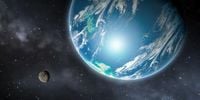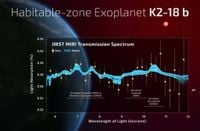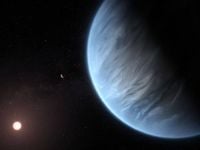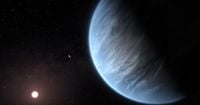In a groundbreaking discovery, scientists using the James Webb Space Telescope have found what they describe as the "most convincing indication of life on a planet outside our solar system" in the atmosphere of K2-18b, a planet located approximately 124 light-years from Earth. The findings, published in The Astrophysical Journal Letters, suggest that K2-18b may be teeming with microbial life, based on the detection of two gases, dimethyl sulfide (DMS) and dimethyldisulfide (DMDS), which are produced exclusively by biological processes on Earth, primarily by microorganisms such as algae.
K2-18b is an immense planet, about 8.6 times heavier and 2.6 times larger than Earth, and it resides in the habitable zone of its star, allowing for conditions that could support liquid water. Previous observations of K2-18b had already indicated the presence of methane and carbon dioxide in its atmosphere, hinting at its classification as a "hycean planet," which is believed to be covered in water and possess a hydrogen-rich atmosphere.
The recent observations were made using Webb's MIRI (Mid-Infrared Instrument), which provided strong evidence for the presence of DMS and/or DMDS. Researcher Nikku Madhusudhan, who leads the study at the University of Cambridge, noted, "This is an independent line of evidence, utilizing a different instrument and wavelength range than before. The signal came through strong and clear."
To detect these gases, researchers observe the moment when K2-18b passes in front of its host star, allowing some of the star's light to filter through the planet's atmosphere. This light interacts with various gases, altering the spectrum of the light and revealing the chemical composition of the atmosphere.
While the findings are exciting, Madhusudhan and his colleagues remain cautious. They emphasize that there is still a 0.3 percent chance that their measurements could be incorrect. For their observations to be classified as a definitive scientific discovery, this probability needs to drop significantly, ideally to below 0.00006 percent. Even if future observations yield stronger evidence, it still won’t confirm the existence of life on K2-18b unless researchers can definitively determine that the observed levels of DMS and/or DMDS can only be produced by living organisms.
"Our study is the starting point for all the investigations needed to confirm and understand the implications of these exciting results," said Savvas Constantinou, another researcher involved in the study. Madhusudhan echoed this sentiment, stating, "It is important that we remain very skeptical about our own results, because only by testing them repeatedly can we reach a point where we can be sure. That’s how science works."
Despite the cautious approach, the researchers believe that the presence of DMS and DMDS on K2-18b indicates the potential for a vibrant ecosystem. The theoretical groundwork laid prior to these observations had already suggested that such sulfur-containing gases could exist in large quantities on hycean planets. Now, with observational data to support these theories, the notion of K2-18b being covered by a warm ocean brimming with life appears increasingly plausible.
Stephen Schmidt, a researcher at Johns Hopkins University, commented on the significance of the discovery, stating, "It’s a hint. But we cannot definitively conclude that the planet is habitable." Nonetheless, Madhusudhan described the event as a "revolutionary moment," marking the first time humanity has identified possible biosignatures on a habitable planet, thus entering the era of observational astrobiology.
The implications of this research extend beyond mere speculation. If the findings are confirmed, they could suggest that life is more common in the universe than previously thought. Madhusudhan speculated, "Over decades, we may look back on this moment and recognize it as the time when the living universe came within reach." He emphasized the importance of continued research, stating that the current findings could be a tipping point in answering the age-old question of whether humanity is alone in the universe.
However, the researchers are aware of the challenges that lie ahead. Professor Catherine Heymans from the University of Edinburgh, who is not involved in the study, cautioned that just because DMS and DMDS are produced by microorganisms on Earth, it does not necessarily mean the same is true for K2-18b. She pointed out that other geological processes could also produce these gases, and researchers need to investigate further to eliminate alternative explanations.
Dr. Nora Hänni from the University of Bern echoed this sentiment, suggesting that all other possibilities must be ruled out before claiming the presence of life. "Life is one of the options, but it is one of many," she said, highlighting the need for rigorous scientific validation.
Despite these uncertainties, the Cambridge team remains optimistic. They plan to conduct further observations to confirm their findings and explore the potential for life on K2-18b. Madhusudhan expressed hope, stating, "This is the strongest evidence to date that there may be extraterrestrial life. Realistically, I can say we could confirm this news within 1 or 2 years." As researchers continue their quest for answers, the world watches closely, eager to learn whether K2-18b holds the key to understanding life beyond Earth.









